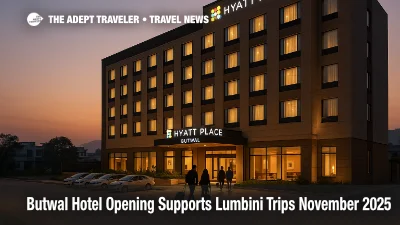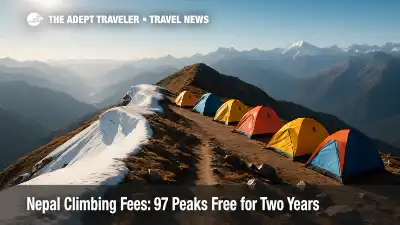Nepal
If you're looking to embark on an unforgettable adventure, traveling to Nepal should be at the top of your list. This majestic country, nestled in the lap of the Himalayas, offers an exquisite blend of natural beauty, rich culture, and thrilling outdoor activities. From the towering heights of Mount Everest to the serene landscapes of the Terai, you will find a diverse array of attractions to quench your wanderlust. When you travel to Nepal, you'll have the chance to trek through pristine trails, explore ancient temples, and immerse yourself in vibrant festivals that showcase the country's unique heritage. For nature enthusiasts, the rugged terrain provides ample opportunities for trekking, mountain climbing, and wildlife safaris. Cities like Kathmandu, Pokhara, and Bhaktapur are replete with historical sites, bustling markets, and culinary delights that will tantalize your senses. Furthermore, Nepal is a haven for spiritual seekers, offering peaceful monasteries, yoga retreats, and meditation centers that promise inner tranquility. Whether you're an adventurer, a history buff, or a spiritual traveler, Nepal has something to offer. The warmth and hospitality of the Nepalese people will make you feel at home while exploring this captivating country. So, don't miss out on the opportunity to travel to Nepal and experience a journey that promises to be both enriching and exhilarating.
The History of Nepal
Nestled in the lap of the Himalayas, Nepal is a country steeped in rich history and cultural heritage, making it an undeniable magnet for history enthusiasts and avid explorers alike. Travel to Nepal, and you'll find yourself immersed in a time-honored tapestry of ancient traditions, awe-inspiring architectures, and timeless stories that date back thousands of years. Whether it's the historical monasteries, centuries-old temples, or the quintessential folklore passed down through generations, Nepal offers an unparalleled glimpse into the past that will captivate any traveler.
The origins of Nepal trace back to ancient times, with the country's history intricately linked with the influences of numerous kingdoms and empires that once reigned supreme in the region. From the legendary Licchavi dynasty of the 3rd century AD, which witnessed Nepal's golden age of art, architecture, and trade relations, to the powerful Malla rulers who played a pivotal role in shaping the Kathmandu Valley's medieval city-states, travel to Nepal allows one to witness the eons-old legacy that still stands strong today. The captivating Durbar Squares in Kathmandu, Patan, and Bhaktapur provide a living history museum where you can marvel at the grandeur of intricately carved palaces and temples.
Among the myriad of sites, the iconic Pashupatinath Temple stands out as a testament to Nepal's spiritual heritage. As one of the oldest and most sacred Hindu temples in the world, it draws thousands of pilgrims every year, making it a significant landmark for those who travel to Nepal. Equally mesmerizing is the Swayambhunath Stupa, also known as the Monkey Temple. Perched atop a hill in the Kathmandu Valley, this UNESCO World Heritage Site offers panoramic views and an intriguing blend of Hindu and Buddhist symbolism. The ancient city of Lumbini—the birthplace of Lord Buddha—further cements Nepal's historical and religious significance, attracting Buddhists and historians from all corners of the globe.
Beyond its monumental structures and sacred sites, Nepal's history is deeply enmeshed with the daily lives of its people. Engage with the local communities, and you’ll uncover age-old traditions preserved through dance, music, and festivals like Dashain and Tihar. The colorful processions and rituals during these festivals not only offer a spectacle but also an immersion into the values and customs that define this resilient nation. For those planning to travel to Nepal, participating in these festivities offers an authentic peek into the communal spirit and historical continuity that thrives across generations.
Indeed, to travel to Nepal is to embark on an enchanting journey through time, where each monument, tradition, and narrative contributes to a compelling mosaic of historical splendor. With its unique blend of ancient and living history, and a hospitable culture that welcomes travelers with open arms, Nepal is a destination that promises a deeply enriching and unforgettable experience for anyone eager to explore the past.
The Culture of Nepal
Nestled between the majestic peaks of the Himalayas and rich tropical landscapes, Nepal offers a unique cultural tapestry that invites travelers to explore its variegated heritage. The country's diverse ethnic groups, each with its own distinct customs and traditions, ensure that visitors who travel to Nepal are continually enchanted by its vibrant cultural scenes. Whether wandering through the bustling streets of Kathmandu or exploring the serene villages in the Terai, the cultures and people of Nepal provide an enriching and immersive experience.
Traveling to Nepal reveals a mosaic of cultures shaped by Hinduism and Buddhism, the two predominant religions in the country. The cultural practices in Nepal are deeply spiritual, manifesting in numerous festivals, religious ceremonies, and art forms that showcase the nation's rich history. During festivals like Dashain and Tihar, the entire country comes alive with colorful decorations, traditional music, dance, and community gatherings. These events offer a unique opportunity to witness the heart and soul of Nepalese culture, as locals warmly welcome travelers to join in their celebrations.
The people of Nepal are known for their unmatched hospitality and kindness, making any travel to Nepal a genuinely heartwarming experience. With over 120 ethnic groups, each community imparts a distinctive charm to the nation's cultural fabric. Ethnic groups such as the Sherpas from the Everest region, the Gurungs and Magars of the Annapurna region, and the Tharus of the southern plains each contribute unique customs, traditional dances, music, and crafts. Engaging with these communities offers travelers an authentic glimpse into the everyday lives and enduring traditions that have been passed down through generations.
Another compelling reason to travel to Nepal is its living heritage sites. The Kathmandu Valley alone boasts seven UNESCO World Heritage Sites, including the ancient cities of Kathmandu, Bhaktapur, and Patan, which are home to stunning temples, palaces, and courtyards. These architectural masterpieces are not just tourist attractions but active places of worship and cultural hubs where traditional rituals and festivals are regularly performed. Exploring these historical sites provides travelers with a profound understanding of Nepal's architectural and artistic grandeur, intertwined with the lives of its people.
Moreover, the traditional Nepali cuisine is an integral aspect of the cultural experience when traveling to Nepal. From the savory momos (dumplings) to the hearty dal bhat (lentil soup with rice), each dish tells a story of the region from which it originates. Dining with local families or at traditional restaurants allows travelers to savor authentic flavors while learning about the culinary customs that define Nepalese life. This gastronomic journey is a delectable complement to the rich cultural experiences that Nepal has to offer.
In essence, traveling to Nepal is not just an exploration of its stunning landscapes but an immersion into a cultural kaleidoscope that is both ancient and alive. The warmth and hospitality of its people, deeply spiritual traditions, vibrant festivals, and historical heritage create a compelling mosaic that promises to captivate and inspire. For those seeking a profound, culturally enriching travel experience, Nepal stands as an extraordinary destination where every moment is a new discovery.
The Food of Nepal
Embark on an unforgettable journey and travel to Nepal, where the culinary experience is as diverse and captivating as its breathtaking landscapes. From the bustling streets of Kathmandu to the serene villages in the Himalayas, the rich tapestry of Nepalese cuisine offers a delicious blend of flavors, textures, and aromas that will entice any food lover's palate. Your travel to Nepal promises not only an adventure through majestic mountains and historic sites but also a gastronomic adventure that delves deep into the heart of Nepal's cultural heritage.
The gems of Nepalese cuisine are undoubtedly the traditional dishes that have been passed down through generations. The iconic "Dal Bhat" is more than just a meal; it is a way of life for Nepalese people. Comprised of lentil soup (dal), steamed rice (bhat), and complemented by an array of accompaniments like spicy pickles (achar), curried vegetables, and occasionally meat, this dish provides an explosion of flavors in every bite. As you travel in Nepal, trying Dal Bhat at local eateries and home-stays will give you a genuine taste of daily Nepalese life and hospitality.
Momos and Street Food Delights
While Dal Bhat represents the staple diet, travelers to Nepal should not miss out on the myriad of street food delights that are a culinary marvel in themselves. Amongst the most beloved are "Momos," Tibetan-inspired dumplings filled with minced meat or vegetables, served with a tangy dipping sauce. As you meander through the vibrant streets of Kathmandu or Pokhara, the aroma of freshly steamed or fried momos is sure to entice you. Additionally, indulge in “Chatamari,” often referred to as Nepalese pizza, or “Sel Roti,” a traditional ring-shaped rice bread; these unique flavors are a testament to Nepal's versatile culinary culture.
Regional and Ethnic Cuisines
Your travel to Nepal will be incomplete without exploring the regional and ethnic cuisines that provide deeper insights into the country’s diverse cultures. In the Newari cuisine of the Kathmandu Valley, "Sukuti" (dried meat), "Yomari" (sweet dumplings filled with sesame and jaggery), and "Bara" (savory lentil pancakes) are must-tries. The Thakali cuisine, with its emphasis on simplicity and balance, offers dishes like "Thakali Khana Set," which features buckwheat dhido, local greens, and pickled radishes, showcasing not just taste but the nutritional wisdom embedded in Nepalese food traditions. Foods from the mountainous regions incorporate ingredients like yak cheese and buckwheat, providing energy and warmth which is essential to the local population living in higher altitudes.
In your quest to travel to Nepal, the culinary treasures you encounter will not only be a feast for your senses but also provide an intimate connection to the country's rich culture and traditions. Each meal tells a story, each flavor unveils a different aspect of Nepalese heritage, and every bite beckons you to learn more about the people and their way of life. Whether it’s dining at a high-end restaurant, enjoying a homemade meal at a local’s home, or sampling street food from a bustling market, your culinary travel to Nepal promises to be a truly sumptuous experience, blending adventure, culture, and gastronomy in perfect harmony.
What to See and Do in Nepal
Travel to Nepal is an adventure of a lifetime, offering a rich tapestry of cultural heritage, stunning landscapes, and outdoor activities. Whether you are a seasoned traveler or a first-time visitor, Nepal has something spectacular to offer. Here are ten detailed must-do activities for every traveler in this Himalayan gem.
Explore the Wonders of Kathmandu, Nepal
No travel to Nepal is complete without exploring Kathmandu. The capital city is a sensory overload of sights, sounds, and smells. You must visit the UNESCO World Heritage Sites like the Swayambhunath Stupa (Monkey Temple), Pashupatinath Temple, and Boudhanath Stupa. Walking through the medieval streets of Durbar Square will transport you back in time with its ancient palaces, courtyards, and temples. Don't forget to take a rickshaw ride through the bustling Thamel Market for some local shopping and street food highlights.
Experience Tranquility in Pokhara, Nepal
Pokhara is renowned for its serene lakes and breathtaking Himalayan views. When you travel to Nepal, make sure to visit Phewa Lake where you can enjoy boating amidst the tranquil waters and capture views of the Annapurna range. Paragliding from Sarangkot is a thrilling way to get an aerial view of this picturesque city. Additionally, visit the International Mountain Museum to learn about the history and culture of mountain climbing in Nepal.
Embark on a Trekking Adventure in the Annapurna Region
Trekking is an integral part of travel to Nepal. The Annapurna Circuit is one of the most popular treks, offering diverse landscapes ranging from lush subtropical forests to alpine heights. This challenging trek will also take you through traditional village settlements, giving you a chance to interact with local ethnic communities like Gurungs and Thakalis. Make sure to prepare adequately for this high-altitude experience.
Discover the Wild Side in Chitwan National Park
Nature and wildlife enthusiasts should not miss Chitwan National Park. Located in the lowlands of Nepal, Chitwan offers a completely different terrain and climate compared to the mountainous regions. Here, you can go on a jungle safari to spot one-horned rhinoceroses, Bengal tigers, and a variety of migratory birds. Canoeing on the Rapti River offers a relaxed view of the park’s aquatic life and surrounding forest.
Immerse Yourself in the Cultural Vibe of Bhaktapur, Nepal
Traveling to Nepal provides a plethora of opportunities to dive into its rich cultural tapestry, and Bhaktapur is the perfect place for this experience. Roam around Bhaktapur Durbar Square with its intricately carved wooden temples, monuments, and courtyards. Try local delicacies like juju dhau (king curd) and learn about traditional pottery at the Pottery Square. The historical charm of Bhaktapur, set against its ancient architectural backdrop, is simply enchanting.
Witness the Vast Beauty of Sagarmatha National Park
Sagarmatha National Park, home to Mount Everest, is a natural wonder that should not be missed while you travel to Nepal. Engage in treks that range from moderate to extremely challenging, such as the trek to Everest Base Camp. Along the way, pass through Sherpa villages where you can learn about the unique culture and traditions of the Sherpa people. The view of Everest from Kala Patthar, especially at sunrise, is an awe-inspiring spectacle worth every step of the climb.
Take a Pilgrimage to Lumbini, Nepal
Lumbini is the birthplace of Lord Buddha, making it a revered pilgrimage site for Buddhists worldwide. The Maya Devi Temple, Ashoka Pillar, and various monastic zones constructed by different countries offer a peaceful and spiritual experience. Wander through the serene gardens and take part in meditation sessions that help you connect deeply with the teachings of Buddha.
Venture into the Mountain Beauty of Mustang
Mustang, also known as the Mini Tibet of Nepal, presents a unique and isolated Himalayan culture. The ancient Kingdom of Lo offers stark landscapes, medieval forts, and hidden caves. Visit the walled city of Lo Manthang to explore its royal palace and ancient monasteries. Mustang offers an otherworldly experience as it feels like you have stepped into a different era.
Relax in the Hot Springs of Tatopani
After rigorous trekking and exploration, Tatopani's hot springs provide a perfect retreat. Located in the Mustang district, these natural hot springs are believed to have healing properties. Relaxation here is complemented by scenic views of the surrounding hills and the Kali Gandaki River, making it a rejuvenating experience for both body and soul.
Cherish the Ethnic Traditions in Bandipur, Nepal
Bandipur is a beautifully preserved town that offers a glance at the Newari culture and traditions. The pedestrian-only streets are lined with traditional houses and temples. Engage with locals, participate in cultural events, and taste authentic Newari cuisine. Visit the Siddha Gufa cave, one of Nepal's largest, for an adventurous subterranean experience. This quaint town is a blend of culture, tradition, and natural beauty, making it a must-visit on your travel to Nepal.
Travel to Nepal promises a mix of adventure, culture, and natural beauty that is unparalleled. Each destination presents a unique aspect of this magical land, making your journey through Nepal an unforgettable experience.
Why You Should Travel to Nepal
Travelers worldwide are enchanted by the allure of Nepal, a country that offers an unparalleled mix of natural beauty, rich culture, and adventure. Nestled in the heart of the Himalayas, Nepal is home to eight of the world's ten highest peaks, including the iconic Mount Everest. For those who seek to immerse themselves in nature, the trekking trails of Nepal offer breathtaking vistas, pristine landscapes, and a chance to interact with warm, hospitable locals in remote mountain villages. The Annapurna Circuit and the Everest Base Camp trek are just a couple of the famous journeys that attract outdoor enthusiasts yearning to experience the grandeur of the Himalayas first-hand.
Nepal is equally celebrated for its cultural richness and historical significance. As the birthplace of Gautam Buddha, Lumbini attracts millions of pilgrims and spiritual seekers from around the globe. The Kathmandu Valley, with its ancient temples, stupas, and palaces, serves as an open-air museum showcasing centuries-old artistry and craftsmanship. Cities like Kathmandu, Patan, and Bhaktapur are dotted with UNESCO World Heritage Sites, which include Bhaktapur Durbar Square and the Swayambhunath Stupa (commonly known as the Monkey Temple). These cultural treasures provide visitors with a glimpse into Nepal's diverse and layered history, forming a backdrop of spiritual and architectural splendor that is rarely found elsewhere.
For the adventure traveler, Nepal is nothing short of paradise. Besides trekking, the country offers an array of adrenaline-pumping activities such as white-water rafting on the Trishuli River, paragliding in Pokhara, and jungle safaris in Chitwan National Park. Pokhara, with its serene Phewa Lake and panoramic mountain views, serves as an ideal base for many adventure sports. The diverse topographical features of Nepal make it a magnet for thrill-seekers who yearn to combine nature with adventure in their travel experiences.
If you're contemplating your next travel destination, a trip to Nepal should be at the top of your list. This unique country offers a blend of majestic natural settings, profound cultural experiences, and endless opportunities for adventure that cannot be matched. Travel to Nepal to explore ancient temples, trek through some of the world’s tallest mountains, and immerse yourself in a rich tapestry of cultures and traditions. Whether you're seeking serenity, spirituality, or excitement, a travel to Nepal promises to fulfill your wanderlust with unforgettable memories.
Tips & Tricks for Traveling in Nepal
Nepal, nestled in the heart of the Himalayas, offers a wealth of experiences for travelers. From its breathtaking landscapes to its rich cultural heritage, travel to Nepal can be a fulfilling adventure. To make your journey even more rewarding, here are ten tips and tricks to enhance your travel to Nepal.
1. Plan Your Travel Season Carefully
The best times to travel to Nepal are during the spring (March to May) and autumn (September to November). These seasons offer excellent weather conditions for trekking and sightseeing. Avoid the monsoon season (June to August) as it brings heavy rains, making travel challenging and potentially hazardous.
2. Obtain the Necessary Permits
Nepal requires several permits for trekking and travel in certain regions. Ensure you have the Trekker’s Information Management System (TIMS) card and relevant permits for restricted areas, such as the Annapurna Conservation Area Permit (ACAP) or the Sagarmatha National Park Permit for Everest. Applying for these permits in advance can save you time.
3. Respect Local Customs and Traditions
Nepal is rich in culture and tradition. It's essential to respect local customs, including dressing modestly. When visiting temples or religious sites, cover your shoulders and knees. Also, remember to remove your shoes before entering such places. A little cultural sensitivity goes a long way in making your travel to Nepal a positive experience.
4. Stay Hydrated and Eat Wisely
Altitude sickness is a common concern for travelers in Nepal, especially those trekking in the mountains. Drink plenty of water to stay hydrated, and avoid consuming alcohol and caffeine before altitude acclimatization. Stick to freshly cooked meals and be cautious with street food to prevent stomach issues.
5. Use Local Guides and Porters
Hiring local guides and porters supports the local economy and enhances your travel experience with their extensive knowledge of the region. They can help navigate difficult trails, provide insights into local culture, and offer safety tips. Additionally, hiring porters will make your trek more comfortable by carrying your heavy loads.
6. Have a Flexible Itinerary
While it's good to have a plan, flexibility is key when traveling in Nepal. Weather conditions, transportation delays, and unexpected events can alter your schedule. A flexible itinerary allows you to adapt to such changes without stress, making your travel more enjoyable and less rushed.
7. Learn Basic Nepali Phrases
Although English is widely spoken in tourist areas, learning a few basic Nepali phrases can be very helpful. Simple greetings and courteous expressions like "Namaste" (hello) or "Dhanyabad" (thank you) can go a long way in building rapport with locals and enhancing your travel to Nepal.
8. Invest in Good Travel Insurance
Travel insurance is highly recommended for anyone planning to travel to Nepal. It should cover medical emergencies, trip cancellations, and, importantly, trekking-related incidents, including helicopter evacuation. The peace of mind that comes with good insurance allows you to enjoy your journey without worry.
9. Pack for Diverse Weather Conditions
Nepal’s weather can be unpredictable, especially in the mountains. Pack layers to cater to temperature changes, including thermal wear, a waterproof jacket, and sturdy trekking boots. Remember to bring a good quality sleeping bag if you plan on trekking since accommodations can be basic and cold.
10. Support Sustainable Tourism
Sustainable travel practices are crucial for preserving Nepal’s natural and cultural heritage. Choose eco-friendly accommodation, avoid single-use plastics, and respect wildlife and flora. Participating in community-based tourism initiatives not only enriches your experience but also supports local communities
Other Places You Might Like
Mysore, India - Nestled in the southern part of India, Mysore is a city that exudes old-world charm blended with vibrant culture, much like what one experiences during a travel to Nepal. Known as the cultural capital of Karnataka, Mysore is famous for its grand palaces, tranquil gardens, and bustling markets. The Mysore Palace, with its impressive facade and rich historical significance, draws comparisons to the architectural marvels in Kathmandu. Enjoying a brisk walk through the Chamundi Hills offers an experience akin to the Himalayan treks loved by travelers to Nepal. Furthermore, Mysore's Dasara festival brings a dash of tradition and festivity that can rival the vibrant Dashain and Tihar festivals in Nepal.
Luang Prabang, Laos - Set where the Mekong River meets the Nam Khan, Luang Prabang is a UNESCO World Heritage city that mirrors the serene and spiritual energy often found in Nepal's sacred sites. The city is renowned for its well-preserved architecture, including numerous Buddhist temples and monasteries. Those who travel to Nepal to seek spiritual solace can find a similar tranquil atmosphere in Luang Prabang’s ancient temples like Wat Xieng Thong and Wat Mai. The daily alms-giving ritual to the monks can evoke feelings akin to participating in the rituals at Pashupatinath Temple in Kathmandu. Visitors can also take river cruises to nearby waterfalls and caves, somewhat reminiscent of the Pokhara boat rides on Phewa Lake.
Thimphu, Bhutan - Located in the breathtakingly beautiful Himalayan range like Nepal, Thimphu, Bhutan’s capital, offers majestic mountain views, monasteries, and a unique blend of modernity and tradition. Just as Nepal is celebrated for its monasteries and stupas, Thimphu boasts impressive structures such as Tashichho Dzong and the Memorial Chorten. The vibrant local markets and traditional crafts will remind visitors of the bustling markets in Kathmandu’s Thamel area. For those who love the treks in Nepal, the hikes in the surrounding valleys and mountains of Thimphu are equally captivating.
Sapa, Vietnam - Known for its stunning terraced fields and ethnic minority communities, Sapa in northern Vietnam bears an uncanny resemblance to the rural and mountainous regions of Nepal, like the Annapurna circuit. Travelers to Nepal who relish the trekking experiences will find Sapa's trails equally exhilarating. The breathtaking views of the Hoang Lien Son Mountain range and the Fansipan peak can be likened to the awe-inspiring vistas of the Himalayan peaks. The local H’mong and Dao inhabitants add a rich cultural layer to the experience, much like the various ethnic groups in Nepal.
Leh, India - Perched high in the Indian Himalayan region, Leh in Ladakh mirrors the dramatic landscapes and cultural richness that is typical of Nepal. With its Tibetan Buddhist monasteries, such as Thiksey Monastery and Hemis Monastery, Leh shares a spiritual connection similar to Lumbini, the birthplace of Buddha in Nepal. The thrilling Leh-Manali highway, similar to the adventurous trails leading to Everest Base Camp, attracts those who travel to Nepal for its adrenaline-pumping adventures. The local cuisine in Leh, with its various teas and stews, echoes the flavors and warmth found in Nepali eateries.
Paro, Bhutan - Steeped in history and blessed with stunning natural beauty, Paro is an enchanting destination that travelers to Nepal will find absolutely mesmerizing. Known for the iconic Taktsang Monastery, also known as Tiger’s Nest, the town offers a blend of spirituality and adventure reminiscent of trekking routes like Everest Base Camp in Nepal. The lush valleys and serene rivers create a tranquil atmosphere similar to that found in the more peaceful regions of Nepal. Exploring Paro’s ancient temples, traditional farms, and local markets offers an immersive experience comparable to journeying through Nepal's countryside and cultural hotspots.
Lhasa, Tibet (China) - As the spiritual heart of Tibet, Lhasa is home to the iconic Potala Palace and Jokhang Temple, making it an essential pilgrimage site just like Nepal’s many sacred locations. Anyone who has traveled to Nepal to witness its devotion and grandeur would find Lhasa’s spiritual vibe captivating. The city’s surroundings are graced with high-altitude landscapes and ancient monasteries, echoing the highland monasteries and mountainous terrains in Nepal. The captivating blend of Tibetan culture and history provides an enriching experience, much like exploring the cultural depth of Nepal.
Butwal, Nepal

Karnali Province, Nepal

Kathmandu, Nepal

Lumbini Province, Nepal

Lumbini, Nepal

Sudurpaschim Province, Nepal

Butwal Hotel Opening Supports Lumbini Trips November 2025

REI Teams With Intrepid For Member Adventure Trips

Intrepid unveils Premium Walking and Trekking on 10 trips

Nepal Climbing Fees: 97 Peaks Free for Two Years

Is It Safe to Drink the Water in Asia? Comprehensive Guide

Visa Requirements for U.S. Travelers: A Global Guide

